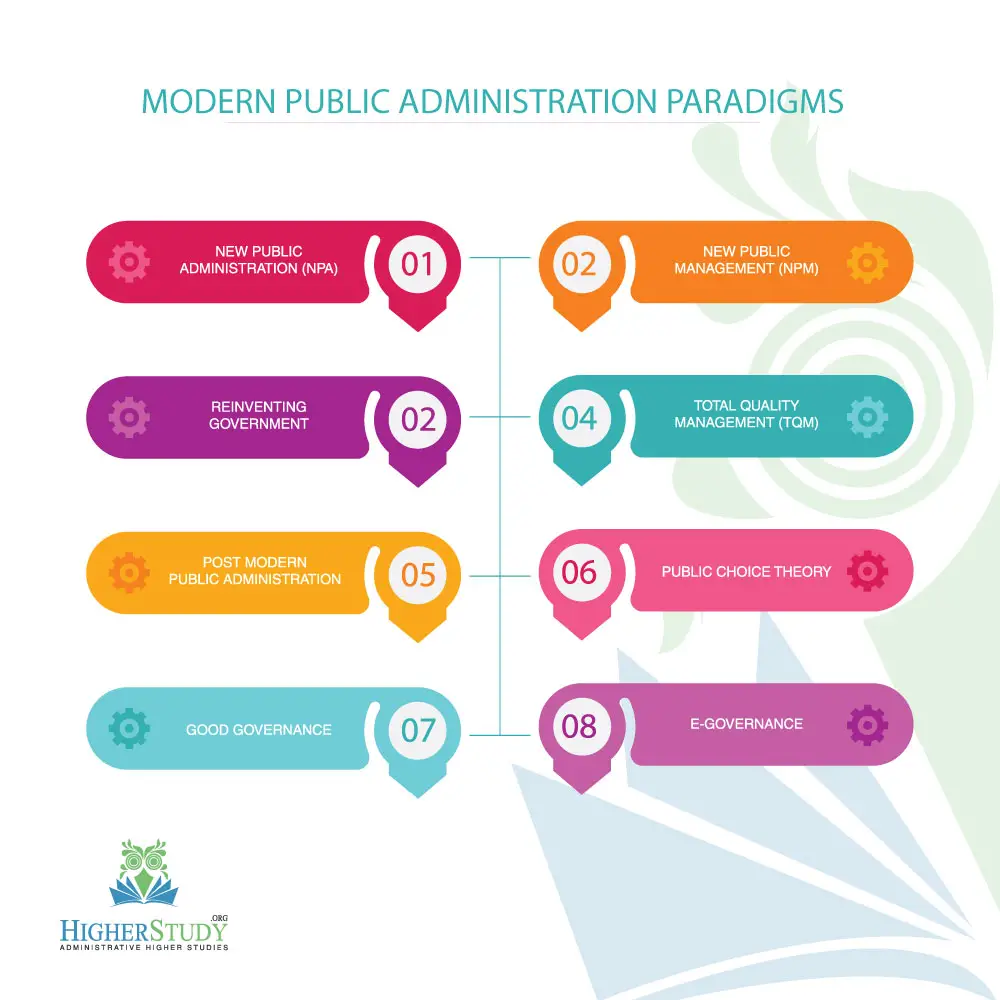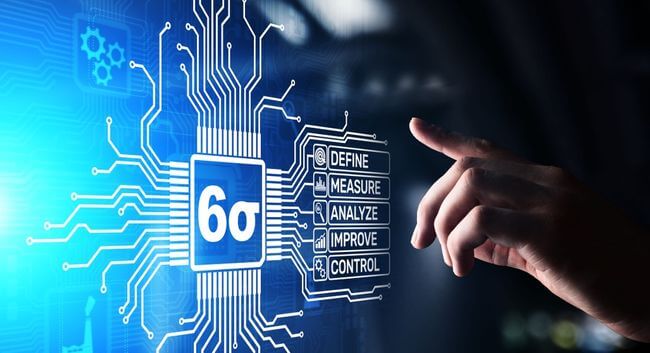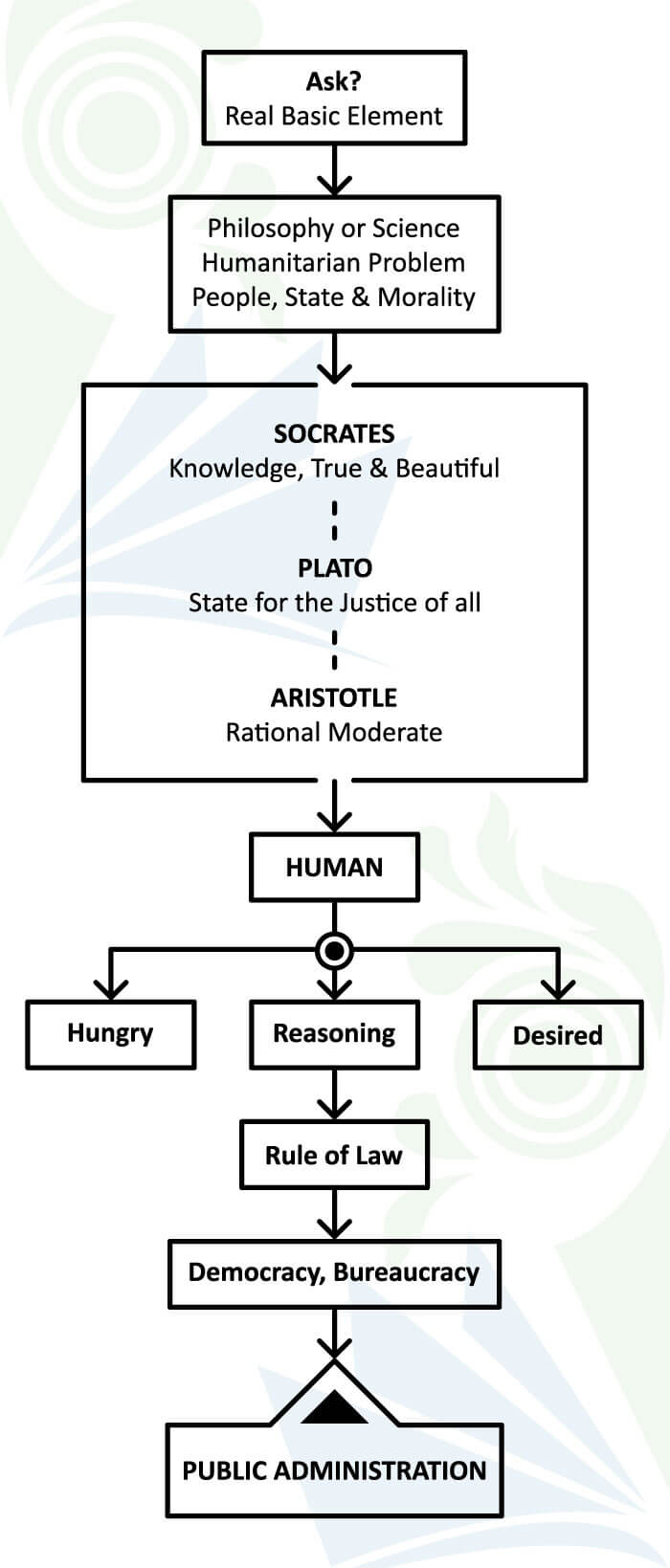Modern Public Administration Paradigms
Public administration is a government policy implementation. And the academic discipline that studies this implementation and preparedness of civil servants for public service work. Public administration has sound paradigms. Its paradigm is two types. One Traditional Public Administration Paradigms and other Modern Public Administration paradigms. These two things come from the evolution of public administration. This article will discuss the modern public administration paradigm.
Table of Contents
Modern Public Administration Paradigms
There are mentioned the Modern Public Administration Paradigms. There will be no broad discussion; point out for coding the main concept. Such as:-
- New Public Administration (NPA)
- New Public Management (NPM)
- Reinventing Government
- New Public Services (NPS)
- Total Quality Management (TQM)
- Post-Modern Public Administration
- Public Choice Theory
- Good Governance
- e-Governance

New Public Administration (NPA)
The New Public Administration (NPA) emerged from the Minnowbrook Conference in 1968. It was inspired by Dwight Waldo, who brought together young administrators and scholars to discuss the crucial issues and varying perspectives of public administration. Developing this field has conveyed the new public administration theory.
New Public Management (NPM)
David Osborne & Ted Gaebler are the fathers of New Public Management (NPM). This concept was coded in their book Reinventing Government – How the Entrepreneurial Spirit is Transforming the Public Sector. Some key points are most important in new public management (NPM). Such as:-
- The individual responsibility of the manager or administrator has been more significant.
- Creating flexibility and dynamics of organizational structure, staff, and job conditions.
- Spontaneously identified the organization and employee’s aims and purposes.
- Ensured 3Es (Economy, Efficiency & Effectiveness)
- Government activities should be formed market-oriented. Public administration not only dealt with bureaucratic complexity but flexibility also.
- Government activities should be adequate.
Reinventing Government
David Osborne & Ted Gaebler are the fathers of Reinventing Government. This concept was coded in their book Reinventing Government – How the Entrepreneurial Spirit is Transforming the Public Sector. There are included the 10 (ten) principles, which are most important in Reinventing Government. Such as:-
- Catalytic government: Steering rather than rowing
- Community-owned government: Empowering rather than serving.
- Competitive government: Injecting competition into service delivery
- Mission-driven government: Transforming rule-driven organizations
- Results-oriented government: Funding outcomes, not inputs
- Customer-driven government: Meeting the needs of the customer, not their bureaucracy
- Enterprising government rather than spending
- Anticipatory government: Prevention rather than cure
- Decentralized government: From hierarchy to participation and teamwork
- Market-oriented government: Leveraging change through the market
New Public Services (NPS)
Janet V. Denhardt & Robert B. Denhardt are provided with this concept in their book The New Public Service – Serving, not Steering. There are seven principles. Such as:-
- Serve rather than Steer
- Serve Citizens, not the Customers.
- Seek the Public Interest
- Think Strategically; Act Democratically.
- Value People; not just Productivity
- Value Citizenship over Entrepreneurship
- Recognize that Accountability is not Simple
Total Quality Management (TQM)
W. Edwards Deming made the concept of TQM. He provided 14 points on TQM. Total Quality Management (TQM) is the management framework that ensures long-term customer satisfaction by improving work culture, process system, etc. Edwards Deming proposed it. It has five principles. Such as:-
- Management’s commitment
- Focus on the customer and the employee
- Focus on fact
- Continuous improvement (KAIZEN: KAI = change & ZEN = improvement); in KAIZEN has a circle. That name is PDCA. PDCA = Plan, Do, Check & Act
- Everybody participation
Post-Modern Public Administration
The modern paradigm of public administration often emphasizes the importance of democratic values over bureaucratic ones. Bureaucratic structures, while efficient in some regards, can sometimes lead to a disconnect between the government and the people it serves. This can result in certain groups feeling marginalized or excluded from the decision-making process.
By prioritizing democratic values, such as transparency, accountability, and citizen participation, governments can strive to create more inclusive and responsive systems of governance. This approach aims to ensure that the voices of all citizens are heard and that government actions are guided by the principles of fairness and equity.
In essence, by emphasizing democratic values, modern public administration seeks to create governance structures that are more reflective of the diverse needs and perspectives of society as a whole, thereby promoting greater legitimacy and trust in governmental institutions.
So, administrators try to ensure the “facts and truth level” in their administrative activities by installing a democratic organization.
Public Choice Theory
James Buchanan is a Novel Prize winner for his contribution to “Public Choice Theory.” Public Choice Theory is one of the Modern Public Administration Paradigms. He focuses on two main things. Such as:-
- Self-Interest: Buchanan argued that individuals, including politicians, bureaucrats, and citizens, act in their self-interest rather than solely for the public good. This means that decision-makers are motivated by personal goals, such as reelection, career advancement, or financial gain.
- Utility Maximization: Building on the concept of self-interest, Buchanan proposed that individuals seek to maximize their utility or satisfaction when making decisions. This includes weighing the costs and benefits of different choices and selecting the option that maximizes their welfare.
Good Governance
The features of Good Governance are many. Different institutions and organizations define Good Governance in their way and provide its various features. For example Kautilya 4, UNDP (1997) 9, United Nations (UN) 8, ADB (1995) 4, ADB (1995) 4, UNHCR 5, AfDB 5 features, and World Bank (1989) 6 features with 4 pillars. A summary of them is presented below:
- Transparency – This involves openness in decision-making processes, access to information, and clarity in the actions of government officials and institutions.
- Participation – It refers to the involvement of citizens in the decision-making processes of governance, ensuring that diverse voices are heard and considered.
- Accountability – This entails holding government officials and institutions responsible for their actions and decisions, ensuring that they answer to the public and are subject to oversight mechanisms.
- Responsibility – Government officials and institutions should act responsibly, taking ownership of their duties and ensuring the welfare of the citizens they serve.
- The Rule of Law – This principle ensures that laws are applied fairly and equally to all individuals and that government actions are following established legal frameworks.
- Efficiency & Effectiveness – Good governance involves the efficient and effective use of resources to achieve desired outcomes, maximizing benefits for citizens while minimizing waste.
- Responsiveness – Governments should be responsive to the needs and concerns of the population, promptly addressing issues and providing appropriate solutions.
- Consensus-Oriented – Decision-making processes should aim to build consensus among stakeholders, fostering cooperation and collaboration to achieve common goals.
- Political Stability – A stable political environment is essential for good governance, as it provides the foundation for effective policymaking and implementation.
- Equity and Inclusiveness – Governance should promote fairness and inclusivity, ensuring that all members of society have equal opportunities and access to resources.
- Government Effectiveness – This involves the ability of government institutions to efficiently and competently fulfill their functions and deliver services to the public.
- Control of Corruption – Good governance requires measures to prevent and combat corruption, ensuring integrity and trust in government institutions and processes.
These features collectively contribute to the promotion of good governance, fostering trust, legitimacy, and the well-being of society.
e-Governance
Gartner proposed four phases of e-governance. Such as:-
- Information: Providing basic online information about government services.
- Interaction: Enabling two-way communication between citizens and government.
- Transaction: Facilitating online transactions and service delivery.
- Transformation: Using digital technologies to fundamentally transform governance processes and structures.
We can find several types of governance. For instance:-
- G2G (Government-to-Government): Interactions between government agencies or levels.
- G2C (Government-to-Customer): Services delivered from government to individual citizens.
- G2B (Government-to-Business): Interactions between government and the business community, including regulation and procurement.
Final Thought
The diverse paradigms and types of governance provide a rich tapestry of ideas and methodologies that governments can draw upon to effectively serve their citizens. Whether it’s the traditional models of democratic governance, the efficiency-focused approaches of technocracy, or the community-driven methods of participatory governance, each offers unique insights and tools for addressing the complexities of modern society.
By embracing this diversity and being open to learning from different approaches, governments can better adapt to changing circumstances, improve decision-making processes, and ultimately enhance the quality of public service delivery. This not only fosters trust and confidence in governmental institutions but also ensures that they remain relevant and effective in meeting the evolving needs of the people they serve.



